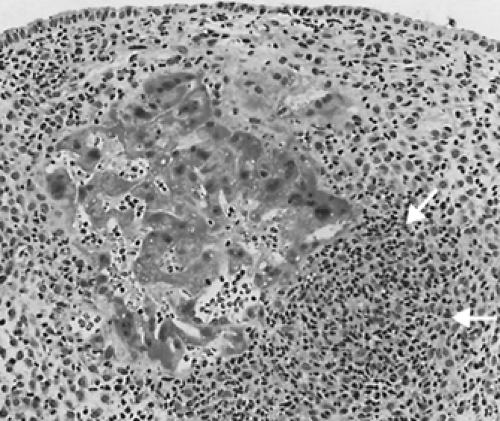PLACENTAL AND TROPHOBLASTIC DEVELOPMENT
Trophoblasts, the principal component of the placenta, are the earliest cells to differentiate in the cleaving, fertilized egg. Four to 5 days after fertilization, they become differentiated from the external cells of the morula as it becomes a blastocyst. Thereafter, trophoblastic cells proliferate rapidly and surround the inner cell mass. Attachment to the surface and implantation occur at 5 to 6 days. In human implantation, the blastocyst sinks and becomes surrounded by endometrium in an interstitial location (Fig. 111-1). The endometrial stroma throughout the uterus soon undergoes decidual change. Several regions are defined: the decidua between the blastocyst and myometrium is the decidua basalis, that covering the surface defect is the decidua capsularis, and that lining the rest of the uterus is the decidua parietalis.1,2 and 3
The trophoblast soon differentiates into three forms—cytotrophoblast, syncytiotrophoblast, and intermediate trophoblast. The first two are often called villous trophoblast, whereas the latter is designated extravillous. Although not wholly accurate, this categorization does denote their predominant sites. The cytotrophoblastic cells are uninucleate with clear cytoplasm, occupying a central location in the villi. Although they retain the capacity for mitosis throughout gestation, little functional differentiation occurs. The peripheral syncytiotrophoblast is nonmitotic and grows through incorporation of cytotrophoblastic nuclei. The cells are irregular and multinucleate with abundant dense cytoplasm. The nuclei are usually small and dark, although, soon after
implantation, they may have inclusion-like nucleoli. The syncytiotrophoblast is functionally active, making large amounts of human chorionic gonadotropin (hCG). The intermediate tropho blast is found predominantly in the implantation site, often admixed with fibrin. The cells are polygonal and uninucleate or multinucleate with abundant amphophilic cytoplasm. Intermediate trophoblast synthesizes predominantly human placental lactogen. All types of trophoblast are epithelial in origin and show such markers (e.g., keratins).3,4 and 5
implantation, they may have inclusion-like nucleoli. The syncytiotrophoblast is functionally active, making large amounts of human chorionic gonadotropin (hCG). The intermediate tropho blast is found predominantly in the implantation site, often admixed with fibrin. The cells are polygonal and uninucleate or multinucleate with abundant amphophilic cytoplasm. Intermediate trophoblast synthesizes predominantly human placental lactogen. All types of trophoblast are epithelial in origin and show such markers (e.g., keratins).3,4 and 5
Stay updated, free articles. Join our Telegram channel

Full access? Get Clinical Tree






